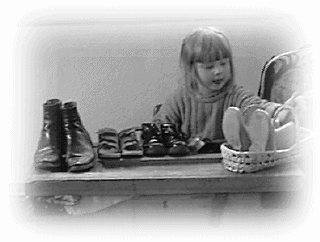Issue
Article
Vol.30 No.3, July 1998
Article
Issue
Issue |
Article |
Vol.30 No.3, July 1998 |
Article |
Issue |

"Hello shop!"
Me and Morgan, my three-year old, are playing shops. One of the reasons for playing shop and doctors and so on is to give children a chance to learn the protocols used in the real world. She is the shop-keeper and I am the customer. As soon as I enter the shop she yells; "Hello shop!".
After a hasty consultation we try again, this time with me as the shop-keeper. "Can I help you?" I ask. "Yes... [pause]". I realise that she is not going to elucidate, so I chime in helpfully with "Good, what do you want?", "Ummm. I want to buy something". Progress is slow. The next half hour provides concrete proof that protocols are vital to a great many real-world interactions.
The phrase E-commerce is starting to buzz on the Internet. The actual interchange of e-money depends on protocols on a system/communication level but the "shop" and "mall" systems that use these transactions also use a protocol in communicating with the user. Usually this protocol is very rigid and restricted, leading to frustration for users and frustration for the developers adapting the rigid "shop" or "mall" system.
It would be wonderful to have a more flexible system that could support all the commerce protocols that we encounter in the real world. Lets have a look at some of them.
Firstly we have the two key elements to a purchase, the two sides of the bargain; getting the product and paying for the product. Very often, if there is some agent playing a part there is an extra element; selection prior to getting the product. Consider a drinks machine, I put my coins in, press the coffee button and out squirts my drink:
"pay - select - get"
In a restaurant I chose from the menu and only pay right at the end of the meal:
"select - get - pay"
When I buy a train ticket, the cashier puts the ticket on one side of a circular tray, I put my money in the other and the cashier pulls a lever that spins it 180 degrees:
"select - pay & get (in parallel)"
Is the order: get - select - pay possible? Well I have heard of a cafe where you sit with your coffees and the waiter puts a bowl of Belgian chocolates on the table. When you pay the bill afterwards the number of chocolates you have eaten is totalled in with the bill.
There is also the question of micro and macro interactions. In a supermarket what really happens isn't "get - pay" but something more like:
"get - get - undo-get - get - get - pay"
A chain of micro-gets like this allows for them to be undone. The undo-get is more difficult if the product is a service; you can't undo phone calls for instance (although I can recall phone calls that I have dearly wanted to).
In principle evaluate is always a part of the protocol:
"get - evaluate - pay"
or money back if you send the goods back:
"get - pay - evaluate - [undo pay - undo get]"
Moving from cafes and shops to the financial markets we find all sorts of bizarre commercial protocols; options for example. I buy the option to buy a specific quantity of a stock at a given price at a given date; buying the chance to buy!
On a more down-to-earth level, I was dwelling on this subject yesterday on the way with Morgan to the cafe La Vallade. When I arrived there, I was confronted with yet another variation: having sat down Bo asked me if I wanted a coffee and an apple juice, to which I replied yes:
"confirm default - get - pay"
And incidentally La Vallade serves food in the evening, one set menu (which is always fantastic):
"get - pay"
Commerce in the real world is a very rich set of interaction protocols with a very complex set of constraints. From the systems point of view the protocols should not allow for abuse of the system. Imagine a drinks machine where you choose your drink, get it and then put your money in. From the user point of view there are also constraints of politeness; the user should not be treated like a grade-one criminal. In many European cafes the protocol gives the user-constraints priority over the integrity of the financial transaction. You sit at a table, order drinks, get them and you only ask for the bill as you leave, a protocol that also applies to restaurants -- although doing a runner from a crowded terrace is easier than doing one from a restaurant (or so I have been told).
Finally the most wonderfully vague protocol I encountered was in Italy. While visiting a well stocked butchers we chose all sorts of delicacies which the butcher elaborately wrapped for us. Only then did we realise that we wouldn't be able to pay for it all. "Domani, domani" he said offering us a bit of ham to try; "tomorrow, tomorrow". E-commerce eat your heart out!
Lon Barfield (lon@design.nl) is a usability expert and lecturer working at General Design Internet Solutions. He is author of `The User Interface, Concepts and Design' (Addison-Wesley) and also writes for "Interfaces" (the user interface magazine of the British HCI Group). He is currently working on a book about multimedia and web design.
Issue |
Article |
Vol.30 No.3, July 1998 |
Article |
Issue |